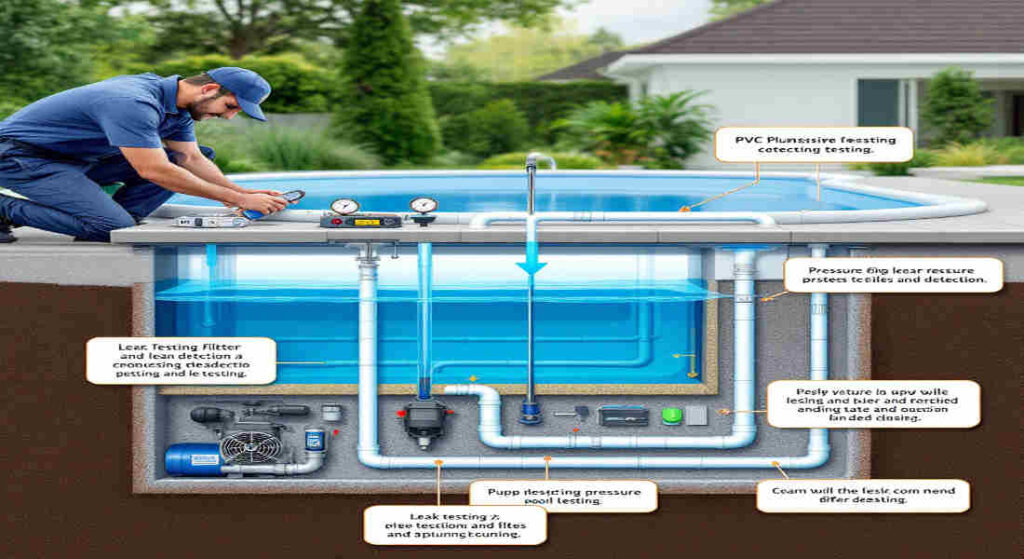A swimming pool is more than just a luxury—it’s a valuable asset that provides relaxation, entertainment, and exercise for your household. However, maintaining it can be challenging, especially when dealing with leaks. A pool plumbing leak not only wastes water but can also lead to costly repairs if left unchecked.
Why Maintaining a Leak-Free Pool is Importan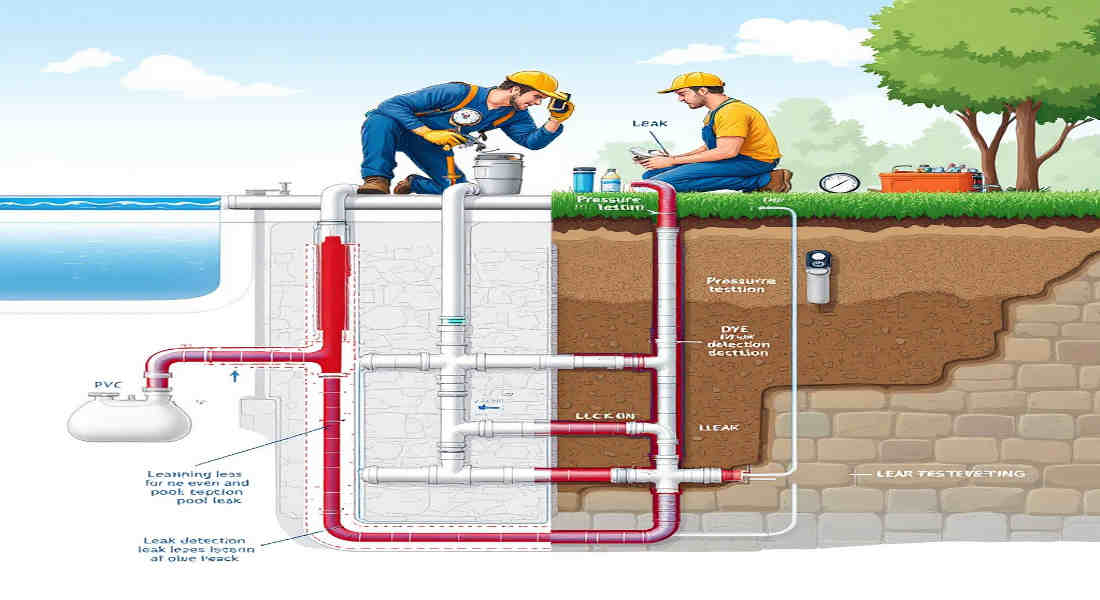
Leaks in your pool plumbing may seem like a minor issue, but they can quickly snowball into bigger problems. Here’s why maintaining a leak-free pool is essential:
- Water Loss: A leaking pool can lose hundreds of gallons of water daily, leading to increased water bills and requiring frequent refilling.
- Structural Damage: Undetected leaks can erode the soil beneath your pool, causing cracks, uneven surfaces, or even severe structural damage.
- Energy Waste: If your pool equipment is working harder to compensate for water loss, you’ll notice higher energy bills.
- Chemical Imbalance: Leaks disrupt the chemical balance of your pool, leading to issues like algae growth, cloudy water, and potential health hazards.
- Costly Repairs: The longer a leak is left untreated, the more expensive it becomes to fix.
By following this guide, you’ll learn how to spot leaks quickly and take action before they escalate into a costly headache.
Understanding Pool Leaks and Their Impact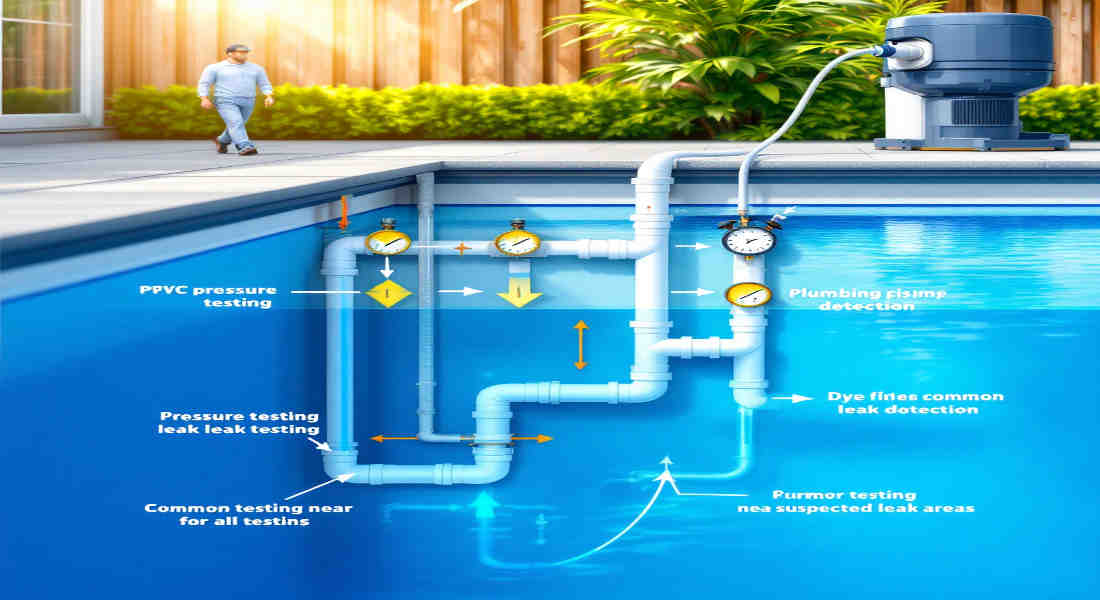
Before diving into the detection process, it’s important to understand what causes leaks, how they manifest, and why addressing them promptly is crucial.
You may also read (clean plumbing pipes at home).
What Causes Leaks in Pool Plumbing?
Pool plumbing leaks are often caused by a combination of wear and tear, environmental factors, and improper installation. Common culprits include:
- Cracked Pipes: Underground plumbing lines are susceptible to cracks from shifting soil, tree roots, or freezing temperatures.
- Loose Fittings: Over time, fittings and connections can loosen due to vibrations from pool pumps or regular use.
- Worn-Out Seals and Gaskets: Rubber seals and gaskets in pool equipment can degrade over time, leading to leaks.
- Ageing Materials: Older pools with outdated plumbing systems are more prone to leaks due to material fatigue.
Signs of a Pool Plumbing Leak
Here are some common signs that indicate your pool might have a leak:
- Water Level Drops: A sudden or consistent drop in your pool’s water level is a clear sign of a potential leak.
- Wet Spots Around the Pool Area: Moist or soggy ground near the pool or equipment indicates water is escaping somewhere.
- Increased Water Bills: A spike in your water bill without any other explanation can point to a leak.
- Algae Growth: Leaks can disturb your pool’s chemical balance, creating a perfect environment for algae to thrive.
- Air Bubbles in Return Jets: If you notice air bubbles coming out of the return jets, there might be a plumbing issue.
Evaporation vs. Actual Leak: The Bucket Test
One of the simplest tests to differentiate between natural evaporation and a leak is the bucket test. Here’s how you can perform it:
- Fill a bucket with pool water and place it on a pool step or deck, ensuring the water level inside the bucket matches the pool’s water level.
- Mark the water levels inside and outside the bucket using a marker or tape.
- Let the bucket sit for 24 hours, ensuring the pool pump is turned off.
- Compare the water levels. If the pool level drops significantly more than the bucket, you likely have a leak.
Initial Checks Before Leak Detection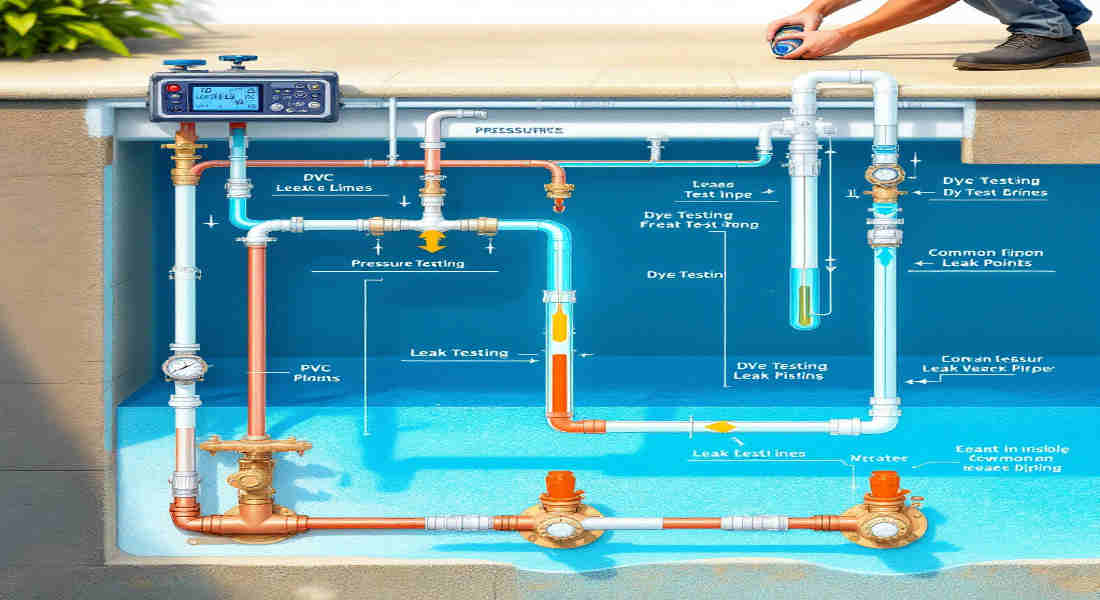
Before diving into advanced techniques, start with some basic checks to rule out obvious issues.
Inspect Visible Pool Plumbing Components
Take a close look at the following components for any visible signs of leaks:
- Pump and Filter System: Check for dripping water, corrosion, or loose fittings.
- Heater and Chlorinator: Inspect seals and connections for any leaks.
- Skimmer and Return Lines: Look for cracks, wet spots, or discolouration around these areas.
Turn Off Pool Equipment
Turning off your pool pump and other equipment can help you isolate the source of the leak. Once turned off, observe whether water continues to escape.
Step-by-Step Guide: How to Find Leaks in a House Pool Plumbing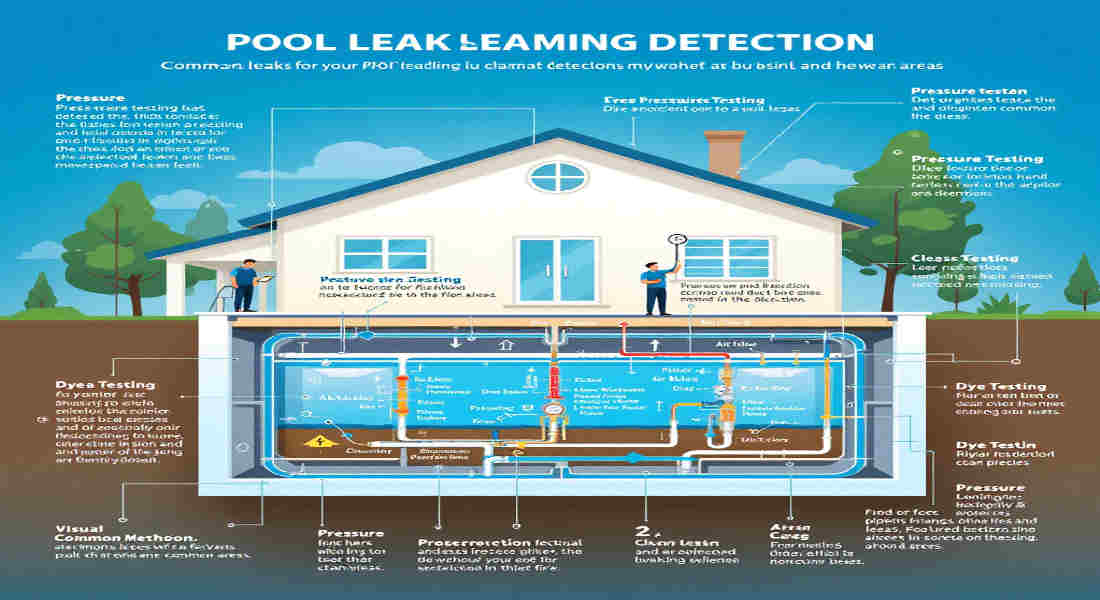
When basic inspections don’t reveal the issue, it’s time to dig deeper. Follow these steps to effectively identify leaks in your pool plumbing.
You may also read (household plumbing systems).
Conduct a Visual Inspection
Carefully inspect your pool and surrounding areas for leaks. Focus on:
- Plumbing Lines: Look for moisture, discolouration, or cracks.
- Pump and Filter System: Check for leaking seals or loose fittings.
- Skimmer and Return Lines: Examine these areas for cracks or signs of wear.
- Decking Around Pool: Wet spots or pooling water under the deck can indicate underground leaks.
Perform a Dye Test
A dye test is a simple yet effective way to pinpoint leaks in your pool. Here’s how:
- Turn off your pool pump to ensure still water.
- Add a few drops of leak detection dye near potential leak areas, such as skimmers, return lines, or visible cracks.
- Observe the dye’s movement. If it’s drawn into a crack or a faulty component, you’ve found the leak.
Pressure Test the Plumbing System
If the leak is within your pool’s plumbing system, a pressure test can help identify the exact location. Here’s a step-by-step guide:
- Gather Tools: You’ll need a pressure gauge, plugs, and adapters for your pool’s plumbing lines.
- Close Valves: Seal off all lines using plugs or valves.
- Attach the Pressure Gauge: Connect it to the suspect plumbing line.
- Pressurise the Line: Use air or water to pressurise the system.
- Monitor Pressure: If the pressure drops over time, there’s a leak in that line.
Inspect Hidden or Underground Pipes
If you suspect an underground leak, consider these steps:
- Look for Soggy Areas: Check for wet soil, grass, or puddles around your pool.
- Use Leak Detection Equipment: Tools like electronic listening devices or thermal cameras can locate underground leaks.
- Hire a Professional: Underground leaks are often difficult to detect without specialised equipment, so consulting an expert might be necessary.
Common Leak Locations in Pool Plumbing
Certain areas of your pool are more prone to leaks. Here’s a list of common problem spots:
Component Common Issues
Pump Seals: Worn-out O-rings or gaskets
Filter Connections: Loose or corroded fittings
Backwash Valves Misaligned or Damaged Valves
Skimmer Cracks or improper installation
Return Lines Cracked or leaking underground pipes
Prioritise inspecting these areas when troubleshooting a leak.
Repair and Maintenance Tips After Leak Detection
Once you’ve identified the leak, here’s how to address it:
- Temporary Fixes: Use waterproof tape or sealants for minor leaks until you can make permanent repairs.
- Replace Damaged Parts: Swap out worn O-rings, seals, or cracked pipes as needed.
- Regular Maintenance: Schedule routine inspections and clean your equipment to prevent future leaks.
- Monitor Water Levels: Keep an eye on your pool’s water level and equipment performance to catch issues early.
When to Call a Professional Leak Detection Service
While DIY methods can be effective, there are situations where professional help is necessary. Call in an expert if:
- You can’t locate the leak despite thorough testing.
- The leak is underground or involves complex plumbing systems.
- You lack the tools or expertise for advanced repairs.
Professionals use specialised equipment and techniques to detect and fix leaks efficiently, saving you time and effort.
You may also read (how to paint home plumbing pipes effectively).
